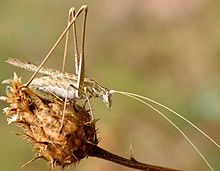en
names in breadcrumbs


Die Lilienblatt-Sichelschrecke (Tylopsis lilifolia) gehört innerhalb der Unterordnung der Langfühlerschrecken zur Unterfamilie der Sichelschrecken (Phaneropterinae).
Die Lilienblatt-Sichelschrecke ähnelt im Körperbau anderen Sichelschrecken-Arten. Ihre Beine sind lang und dünn und tragen an den Unterschenkeln kleine Stacheln. Die Fühler sind länger als der Körper. Im Unterschied zu allen anderen mitteleuropäischen Sichelschrecken besitzt diese ein spaltförmiges Hörorgan. Die Flügel überragen den Körper weit. Die Grundfarbe variiert von hellbraun über olivgrün bis hellgrün. Vom Hinterkopf über Halsschild und Flügelansatz zieht sich ein breites braunes, hellgelb gerandetes Band. Der Rand der Halsschildlappen ist weiß bis hellgelb. Vom Auge bis zu den Flügeln zieht sich ein weißer Strich. Auch auf den Flügeln befinden sich solche Striche. Auf der Innenseite der Hinterschenkel liegt ein weißer Streifen. Der Legebohrer des Weibchens ist kurz, hoch und nach oben gebogen.
Die Lilienblatt-Sichelschrecke findet man häufig auf Gewächsen sitzend. In ihrem Verbreitungsgebiet ist sie recht häufig. Sie kommt rund um das Mittelmeer vor – Nordgrenze ist Südtirol – und bewohnt sonnige Wiesen, Waldränder und andere Landschaften mit viel Bewuchs. Sie ist in Europa in Italien, Slowenien, Kroatien, Bosnien und Herzegowina, Serbien und Montenegro, Makedonien – in Vorderasien auf der Halbinsel Krim, in Georgien, Aserbaidschan, Armenien und der Türkei – verbreitet.
Die Lilienblatt-Sichelschrecke (Tylopsis lilifolia) gehört innerhalb der Unterordnung der Langfühlerschrecken zur Unterfamilie der Sichelschrecken (Phaneropterinae).
Tylopsis lilifolia, the lily bush-cricket, is a species of Orthopterans in the subfamily Phaneropterinae. It is found in Europe and Asia.
This species is present especially in southern Europe (not the British Isles or Scandinavia)[2] and it is widespread in the Mediterranean region. It can also be found in North Africa and in the Near East, in Iran and in the Caucasus. It mainly inhabits sunny meadows, shrubs and forest clearings.[3][4][5]
The adult males grow up to 13–22 millimetres (0.51–0.87 in) long, while females can reach 16–23 millimetres (0.63–0.91 in) of length.[6]
This species has two different forms of color. The basic coloration of the body varies from olive green or pale green to light brown with a brown-yellowish longitudinal band on the back. Head, legs and wings are green. The legs are long and thin, with small spines. The antennae are very long, they reach up to five times the body length. The ovipositor is about 4–5 millimetres (0.16–0.20 in) long [6] and curved upward. In the dry grasslands it is common a brown form of the body.
Adults can be encountered from August through October.[6]
 Brown form
Brown form Tylopsis lilifolia, the lily bush-cricket, is a species of Orthopterans in the subfamily Phaneropterinae. It is found in Europe and Asia.
Tylopsis lilifolia (Fabricius, 1793) è una specie di cavalletta appartenente alla famiglia Tettigoniidae (sottofamiglia Phaneropterinae).[3][4]
I maschi adulti crescono fino a 13–22 millimetri (0,51–0,87 in) di lunghezza, mentre le femmine arrivano a 16–23 millimetri (0,63–0,91 in).[5].
Questa specie presenta due fenotipi per la colorazione del corpo. Quella di base varia da un verde oliva o pallido fino a un marroncino con bande giallastre longitudinali lungo la schiena. La testa, le zampe e le ali sono verdi. Le zampe sono lunghe e sottili, con piccoli aculei. Le antenne sono molto lunghe e possono essere fino a cinque volte più lunghe del corpo. L'ovopositore è lungo 4–5 millimetri (0,16–0,20 in)[5] e curvato all'insù. Nelle pianure asciutte è più comune il fenotipo marrone.
Questa specie è presente nella maggior parte dell'Europa[6], dove è diffusa soprattutto nella regione mediterranea. Può essere osservata anche in Nord Africa, nel Vicino Oriente, in Iran e nel Caucaso. Vive principalmente nei prati soleggiati, tra gli arbusti e nelle radure dei boschi.[4][1]
Gli adulti possono essere osservati generalmente da agosto a ottobre.[5]
Tylopsis lilifolia (Fabricius, 1793) è una specie di cavalletta appartenente alla famiglia Tettigoniidae (sottofamiglia Phaneropterinae).
Tylopsis lilifolia is een rechtvleugelig insect uit de familie sabelsprinkhanen (Tettigoniidae). De wetenschappelijke naam van deze soort is voor het eerst geldig gepubliceerd in 1793 door Fabricius.
Bronnen, noten en/of referenties